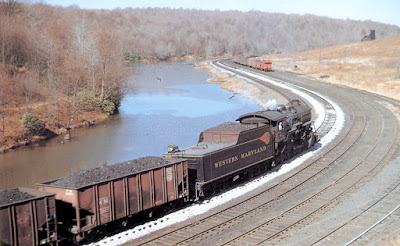West Coast modelers like me have minimal needs for hopper cars, at least for carrying coal. There certainly was some traffic of that kind, as I showed in a post awhile back, but not a great deal of it. (That post can be seen here: https://modelingthesp.blogspot.com/2018/02/coal-in-california.html .) And in fact, I had written more about that topic in an earlier post about coal traffic, and here is that link also: https://modelingthesp.blogspot.com/2016/06/coal-traffic-on-my-layout.html . This latter post in particular goes into the reasons that eastern coal hoppers may appear on my layout.
One can of course choose whatever eastern coal roads one wishes, but in fact some coal roads had far more off-line traffic than others, generally through brokers, compared to the roads whose coal traffic was heavily slanted to export coal piers. One of the roads with significant off-line traffic was the Western Maryland.
Now in one sense, the WM was just another small railroad, but to many, it was a railroad that stood out beyond its size. One reason in steam days was the pride of WM employees, revealed in so many ways, perhaps most visibly in the clean locomotives and tenders. Roundhouse employees wiped down engine jackets and tenders with kerosene between runs.
Innumerable photos show this appearance, though the WM was a hard-working railroad hauling mostly coal. I show just a single example below, one of a great many superb Bill Price photos from his book, Western Maryland Steam Album (published by the Potomac chapter, NRHS, 1985).
This photo shows Class H9 Consolidation 821 at Thomas, West Virginia, in the fall of 1953 (BTW, these were big locomotives). Who would expect gold striping and a color emblem (called a “fireball”) on steam tenders, and invariably kept clean like this? Note also the distinctive WM channel-side hoppers behind the engine.
Years ago, I wanted to model one of these channel-side hoppers, representing some 1500 cars that had 7 channel-section side posts. They were built new this way by Bethlehem Steel in 1927. As it happened, I wrote a piece about my model for Model Railroader’s then-monthly column, called “Paint Shop,” conducted by Jim Hediger, in the June 1983 issue, on page 122. Here’s a photo of my model.
The model is an Athearn “blue box” twin hopper, with ribs carved and sanded off and replaced with Plastruct channel. I also replaced the brake wheel and trucks. I used Champ’s HN-60 WM decal set, and weathered the car, especially the interior. The Athearn body is a little larger than the WM prototype but has close to the same proportions, so looks all right in use.
The other distinctive WM hoppers were often called “drop side” cars, with side sheets extending below the side sill. Cars of this design were not widely owned — the Lehigh Valley, Atlantic Coast Line, and the Reading had some, and the N&W had a lot — but they do stand out on the WM, totalling 4400 cars. That’s a lot on a 13,000-car railroad. Bethlehem Steel built these cars for the WM and the LV. (I should emphasize that the enormous majority of hopper cars in North America had straight side sills.) Here’s an example of the WM drop-side car.
This photo is by Robert Collins, showing a mid-train helper, Class I-2 Decapod 1124, on the Mount Savage grade near Frostburg, Maryland. Note that a channel-side car is visible here also, thus showing both kinds of distinctive 7-rib WM hoppers. Incidentally, this photo is from a book with the wonderful title, The Western Maryland Railway: Fireballs and Black Diamonds, by Roger Cook and Karl Zimmerman, Howell-North, 1981.
Stewart Hobbies years ago produced a styrene model of this drop-side hopper, and I had one in my stash. I decided I should assemble it to keep my channel-side car company. It does have separate ladders, helping the appearance, and I replaced the brake wheel and the wheelsets, while installing Kadee #158 couplers in the kit boxes. It of course needs weathering, which will be applied in an upcoming session for multiple cars from the “paint shop.”
And there is one other point to make, in addition to the distinctive WM locomotive appearance in its heyday. That would be my own experience, when I lived in Pittsburgh, visiting former WM sites like Elkins, West Virginia, during Chessie days (and talking to employees, who would immediately tell you if they had started on the WM). That very much makes it fun to model a bit of the WM. So when I enjoy occasionally spotting a car of eastern “met” coal (metallurgical) at my Jupiter Pump & Compressor industry, it’s especially nice that these two WM hoppers can be among them. But this isn’t the end of the story. More to come.
Tony Thompson




No comments:
Post a Comment